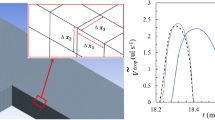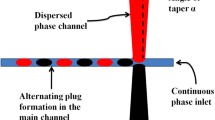Abstract
Herein we report microfluidic droplet formation in flow-focusing geometries possessing varying degrees of rounding. Rounding is incorporated in all four corners (symmetric) or only in the two exit corners (asymmetric). The ratios of the radius of curvature, R, to channel width, w, are varied where R/w = 0, 0.5 and 1. In all cases, monodisperse droplets are produced, with the largest droplets being produced at the junctions with the largest rounding. Junctions without rounding are shown to produce droplets at higher frequencies than those with rounding. Droplet pinch-off position is found to be dependent on both geometry and volumetric flow rates; the location shifts toward the interior of the rounded junctions with increasing oil-to-water flow rate ratios. Accordingly, we find that rounding within microfluidic flow-focusing junctions strongly influences droplet formation. Junction rounding may be deliberate due to the selected fabrication method or occur as an unintended result of microfabrication processes not held to strict tolerances. Indeed, understanding droplet characteristics for those formed in such structures is critical for microfluidic applications where droplet volume or reagent mass must be well controlled. Thus, rounding can be a valuable design parameter when tuning the size and production frequency for emulsion collection or ensuing downstream operations such as chemical reactions.






Similar content being viewed by others
References
Abate AR, Poitzsch A, Hwang Y, Lee J, Czerwinska J, Weitz DA (2009) Impact of inlet channel geometry on microfluidic drop formation. Phys Rev E 80:026310
Anna SL, Bontoux N, Stone HA (2003) Formation of dispersions using “flow focusing” in microchannels. Appl Phys Lett 82:364–366
Becker H, Dietz W, Dannberg P (1998) Microfluidic manifolds by polymer hot embossing for μ-TAS applications. In: Harrison DJ, van den Berg A (eds) Proceedings of micro total analysis systems. Kluwer, Dordrecht, pp 253–256
Bremond N, Thiam AR, Bibette J (2008) Decompressing emulsion droplets favors coalescence. Phys Rev Lett 100:024501
Chokkalingam V, Weidenhof B, Krämer M, Maier WF, Herminghaus S, Seemann R (2010) Optimized droplet-based microfluidics scheme for sol–gel reactions. Lab Chip 10:1700–1705
Christopher GF, Anna SL (2007) Microfluidic methods for generating continuous droplet streams. J Phys D Appl Phys 40:R319–R336
Courtois F, Olguin LF, Whyte G, Bratton D, Huck WTS, Abell C, Hollfelder F (2008) An integrated device for monitoring time-dependent in vitro expression from single genes in picolitre droplets. ChemBioChem 9:439–446
del Campo A, Greiner C (2007) SU-8: a photoresist for high-aspect-ratio and 3D submicron lithography. J Micromech Microeng 17:R81–R95
Dittrich P, Jahnz M, Schwille P (2005) A new embedded process for compartmentalized cell-free protein expression and on-line detection in microfluidic devices. ChemBioChem 6:811–814
Engl W, Backov R, Panizza P (2008) Controlled production of emulsions and particles by milli- and microfluidic techniques. Curr Opin Colloid Interface Sci 13:206–216
Garstecki P, Stone HA, Whitesides GM (2005) Mechanism for flow-rate controlled breakup in confined geometries: a route to monodisperse emulsions. Phys Rev Lett 94:164501
Gielen F, van Vliet L, Koprowsi BT, Devenish SRA, Fischlechner M, Edel JB, Niu X, deMello AJ, Hollfelder F (2013) A fully unsupervised compartment-on-demand platform for precise nanoliter assays of time-dependent steady-state enzyme kinetics and inhibition. Anal Chem 85:4761–4769
Gordan OD, Persson BNJ, Cesa CM, Mayer D, Hoffmann B, Dieluweit S, Merkel R (2008) On pattern transfer in replica molding. Langmuir 24:6636–6639
Griffiths C, Bigot S, Brousseau E, Worgull M, Heckele M, Nestler J, Auerswald J (2010) Investigation of polymer inserts as prototyping tooling for micro injection moulding. Int J Adv Manuf Technol 47:111–123
Guber AE, Heckele M, Herrmann D, Muslija A, Saile V, Eichhorn L, Gietzelt T, Hoffman W, Hauser PC, Tanjanyiwa J, Gerlach A, Gottschlich N, Knebel G (2004) Microfluidic lab-on-a-chip systems based on polymers—fabrication and application. Chem Eng J 101:447–453
Hupert ML, Guy WJ, Llopis SD, Shadpour H, Rani S, Nikitopoulos DE, Soper SA (2007) Evaluation of micromilled metal mold masters for the replication of microchip electrophoresis devices. Microfluid Nanofluid 3:1–11
Jillavenkatesa A, Dapkunas SJ, Lum L-SH (2001) Particle size characterization. Special Publication 960-1. National Institute of Standards and Technology, Washington
Khan SA, Gunther A, Schmidt MA, Jensen KF (2004) Microfluidic synthesis of colloidal silica. Langmuir 20:8604–8611
Kobayashi I, Takano T, Maeda R, Wada Y, Uemura K, Nakajima M (2008) Straight-through microchannel devices for generating monodisperse emulsion droplets several microns in size. Microfluid Nanofluid 4:167–177
Kobayashi I, Murayama Y, Kuroiwa T, Uemura K, Nakajima M (2009) Production of monodisperse water-in-oil emulsions consisting of highly uniform droplets using asymmetric straight-through microchannel arrays. Microfluid Nanofluid 7:107–119
Kumar K, Nightingale AM, Krishnadasan SH, Kamaly N, Wylenzinska-Arridge M, Zeissler K, Branford WR, Ware E, deMello AJ, deMello JC (2012) Direct synthesis of dextran-coated superparamagnetic iron oxide nanoparticles in a capillary-based droplet reactor. J Mater Chem 22:4704–4708
Lee W, Walker LM, Anna SL (2009) Role of geometry and fluid properties in droplet and thread formation processing in planar flow focusing. Phys Fluids 21:032103
Li W, Young EWK, Seo M, Nie Z, Garstecki P, Simmons CA, Kumacheva E (2007) Simultaneous generation of droplets with different dimensions in parallel integrated microfluidic droplet generators. Soft Matter 4:258–262
Lignos I, Protesescu L, Stavrakis S, Piveteau L, Speirs MJ, Loi MA, Kovalenko MV, deMello AJ (2014) Facile droplet-based microfluidic synthesis of monodisperse IV–VI semiconductor nanocrystals with coupled in-line NIR fluorescence detection. Chem Mater 26:2975–2982
Link DR, Anna SL, Weitz DA, Stone HA (2004) Geometrically mediated breakup of drops in microfluidic devices. Phys Rev Lett 92:054503
Liu H, Nakajima M, Nishi T, Kimura T (2005) Effect of channel structure on preparation of a water-in-oil emulsion by polymer microchannels. Eur J Lipid Sci Technol 107:481–487
Liu K, Zhao L-B, Zeng Q, Guo Z-X, Liu J, Zhao X-Z (2007) Injection angle dependence in flow focusing based droplet formation. In: 1st international conference on bioinformatics and biomedical engineering (ICBBE), pp. 1121–1124
Mulligan MK, Rothstein JP (2012) Scale-up and control of droplet production in coupled microfluidic flow-focusing geometries. Microfluid Nanofluid 13:65–73
Nie Z, Seo M, Xu S, Lewis PC, Mok M, Kumacheva E, Whitesides GM, Garstecki P, Stone HA (2008) Emulsification in a microfluidic flow-focusing device: effect of the viscosities of the liquids. Microfluid Nanofluid 5:585–594
Niu X, Gulati S, Edel JB, deMello AJ (2008) Pillar-induced droplet merging in microfluidic circuits. Lab Chip 8:1837–1841
Niu X, Gielen F, Edel JB, deMello AJ (2011) A microdroplet dilutor for high-throughput screening. Nat Chem 3:437–442
Odom TW, Love JC, Wolfe DB, Paul KE, Whitesides GM (2002) Improved pattern transfer in soft lithography using composite stamps. Langmuir 18:5314–5320
Romero PA, Abate AR (2012) Flow focusing geometry generates droplets through a plug and squeeze mechanism. Lab Chip 12:5130–5132
Song H, Ismagilov RF (2003) Milliseconds kinetics on a microfluidic chip using nanoliters of reagents. J Am Chem Soc 125:14613–14619
Song H, Tice JD, Ismagilov RF (2003) A microfluidic system for controlling reaction networks in time. Angew Chem Int Ed 42:768–772
Srisa-Art M, Bonzani IC, Williams A, Stevens MM, deMello AJ, Edel JB (2009) Identification of rare progenitor cells from human periosteal tissue using droplet microfluidics. Analyst 134:2239–2245
Subramanian B, Kim N, Lee W, Spivak DA, Nikitopoulos DE, McCarley RL, Soper DA (2011) Surface modification of droplet polymeric microfluidic devices for the stable and continuous generation of aqueous droplets. Langmuir 27:7949–7957
Sugiura S, Nakajima M, Seki M (2002) Effect of channel structure on microchannel emulsification. Langmuir 18:5708–5712
Tan Y-C, Cristini V, Lee AP (2006) Monodisperse microfluidic droplet generation by shear focusing microfluidic device. Sens Actuators B 114:350–356
Theberge AB, Courtois F, Schaerli Y, Fischlechner M, Abell C, Hollfelder F, Huck WTS (2010) Microdroplets in microfluidics: an evolving platform for discoveries in chemistry and biology. Angew Chem Int Ed 49:5846–5868
Tice JD, Song H, Lyon AD, Ismagilov RF (2003) Formation of droplets and mixing in multiphase microfluidics at low values of the Reynolds and capillary numbers. Langmuir 19:9127–9133
Um E, Lee D-S, Pyo H-B, Park J-K (2008) Continuous generation of hydrogel beads and encapsulation of biological materials using a microfluidic droplet-merging channel. Microfluid Nanofluid 5:541–549
van Dijke K, Veldhuis G, Schroen K, Boom R (2009) Parallelized edge-based droplet (EDGE) devices. Lab Chip 9:2824–2830
Wong S, Guo W-H, Hoffecker I, Wang Y-L (2014) Preparation of a micropatterned rigid-soft composite substrate for probing cellular rigidity sensing. In: Piel M, Thery M (eds) Methods in cell biology: micropatterning in cell biology part C, vol 121. Elsevier, Oxford, pp 3–15
Wu N, Zhu Y, Brown S, Oakeshott J, Peat TS, Surjadi R, Easton C, Leech PW, Sexton BA (2009) A PMMA microfluidic droplet platform for in vitro protein expression using crude E. Coli S30 extract. Lab Chip 9:3391–3398
Xia Y, Whitesides GM (1998) Soft lithography. Angew Chem Int Ed 37:550–575
Xu S, Nie Z, Seo M, Lewis P, Kumacheva E, Stone HA, Garstecki P, Weibel DB, Gitlin I, Whitesides GM (2005) Generation of monodisperse particles by using microfluidics: control over size, shape, and composition. Angew Chem Int Ed 44:724–728
Acknowledgments
This work was supported in part by the RCUK Microdroplets Basic Technology Project (EP/D048664/1). The authors would like to thank Joshua B. Edel and Andrew J. deMello for useful discussions and the use of their cleanroom facilities to fabricate devices. SG and WG would like to acknowledge support from the School of Engineering and Computer Science at University of the Pacific.
Author information
Authors and Affiliations
Corresponding author
Rights and permissions
About this article
Cite this article
Gulati, S., Vijayakumar, K., Good, W.W. et al. Microdroplet formation in rounded flow-focusing junctions. Microfluid Nanofluid 20, 2 (2016). https://doi.org/10.1007/s10404-015-1680-3
Received:
Accepted:
Published:
DOI: https://doi.org/10.1007/s10404-015-1680-3




